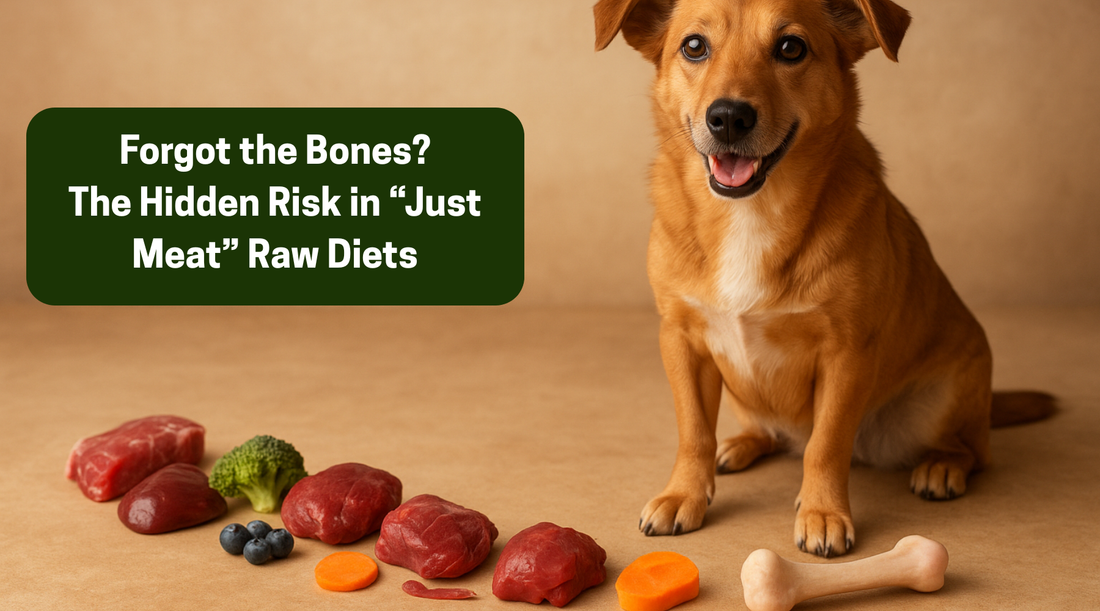Meet the Raw Feeder Who Forgot the Bones
She came into the store beaming.
“I finally switched to raw,” she said proudly. “My dog loves it!”
That’s always music to my ears — another pet parent discovering the joy of feeding fresh, whole foods. But as we chatted, something didn’t quite add up. When I asked what proteins she was using, she smiled and said, “Oh, just chicken and beef. I buy it ground and mix in some blueberries because I heard they’re healthy.”
And there it was — the missing piece of the puzzle.
This enthusiastic raw feeder had forgotten the bones.
It’s more common than you might think. With so much advice online, it’s easy to assume that “raw” just means uncooked meat — but that’s only part of the story.
A true raw diet is about balance. It includes muscle meat, organ, bone, and a small amount of plant matter — all in ratios designed to support a dog’s natural biology.
Without that balance, especially without bone or another natural calcium source, problems can quietly emerge. A shiny coat and a happy appetite might look like success, but beneath the surface, an imbalanced calcium-to-phosphorus ratio can weaken bones, strain the body, and slowly undo all the good intentions of raw feeding.
Why the Calcium–Phosphorus Balance Matters
Every time your dog eats, their body works to balance minerals — and the most important pair is calcium and phosphorus.
Think of them as partners: they keep the skeleton strong, muscles moving, and nerves firing properly.
- Calcium provides structure for bones and teeth and helps muscles contract.
- Phosphorus supports energy production, metabolism, and bone strength.
In nature, these two minerals exist together in bone — in almost the perfect ratio. That’s exactly what your dog’s body expects. Feed only muscle meat, and the balance tips heavily toward phosphorus, leaving calcium behind.
Over time, this imbalance can cause the body to pull calcium from the bones to maintain proper blood levels — resulting in weaker bones, joint strain, and other preventable health issues.
What Happens When There’s Not Enough Calcium
At first, everything seems fine. Your dog eats happily, their coat shines, and all looks well. But beneath the surface, subtle changes are underway:
- Bones weaken: The body pulls calcium from the skeleton to maintain balance, making bones soft or brittle.
- Teeth and jaw suffer: Low calcium can lead to dental wear, fractures, or difficulty chewing.
- Puppies risk improper growth: Growing dogs may develop deformities, growth plate issues, or early arthritis.
- Muscles and nerves misfire: Calcium is key for muscle contractions and nerve signaling; low levels can cause twitching, stiffness, or weakness.
The tricky part? These changes happen slowly. A dog can appear perfectly healthy while their bones gradually lose strength.
Where Natural Calcium Comes From
Commercial raw foods, like Just the Basics Raw, are carefully formulated with the right balance of meat, organ, and bone — keeping the calcium–phosphorus ratio just right.
For those preparing raw meals at home, here are safe, natural ways to provide calcium without synthetic supplements:
- Raw meaty bones — chicken necks, turkey necks, or duck wings provide calcium and phosphorus in perfect harmony.
- Ground bone or bone meal — ideal for dogs who can’t chew whole bones (use only trusted sources).
- Eggshell powder — a clean, bioavailable calcium source; make sure it’s finely ground. Remember, eggshells provide calcium only, not phosphorus.
- Small whole fish — sardines or smelt have soft bones that naturally contribute calcium.
- Balanced raw blends — high-quality commercial options, like Just the Basics Raw, take the guesswork out entirely, ensuring safe and natural ratios.
Why “Just Meat” Isn’t Enough
Muscle meat alone — even the freshest, grass-fed kind — contains very little calcium but plenty of phosphorus. Over time, this imbalance can lead to nutritional secondary hyperparathyroidism, a condition where the body pulls calcium from its own bones to make up for what’s missing in the diet.
The consequences can be serious: fragile bones, spontaneous fractures, and lifelong weakness — all preventable by simply adding bone or another natural calcium source.
That’s why true raw feeding isn’t just about what’s raw — it’s about what’s balanced.
Finding the Right Balance
A good rule of thumb: aim for a calcium-to-phosphorus ratio of about 1.2:1 — slightly more calcium than phosphorus.
For most dogs, this balance occurs naturally when roughly 10% of the diet consists of edible bone, which is built into many high-quality raw diets.
If you prepare meals at home, a little planning goes a long way. Using a trusted recipe or balance calculator, and knowing what’s in each ingredient, helps ensure your dog’s body receives the mineral harmony it needs.
The Heart of the Matter
Feeding raw isn’t a trend — it’s a way to provide dogs with the kind of nourishment their bodies were designed for: fresh, unprocessed, and balanced.
Balance is what keeps their bodies strong, coats shiny, and energy joyful for years to come.
Next time you hear someone say, “I feed raw,” you might smile and ask, “Do you include the bones?”
Because those often-forgotten bones are what truly hold everything together.
Adding the Bones Back In
The woman who proudly came in to tell me she fed raw left with a clearer understanding of what “raw” truly means — and the confidence to make her dog’s meals complete. She didn’t need to start over; she just needed to add the bones back in.
If you’re preparing raw meals at home, or buying meat and calling it “raw feeding,” we can help you take the next step. Bring us the details of what you’re feeding, and we’ll help analyze your dog’s diet to ensure it’s balanced — nutrient-rich, properly proportioned, and designed to help your dog thrive.
After all, feeding raw isn’t just about what’s fresh — it’s about what’s right. And we’re here to help you get it right.

